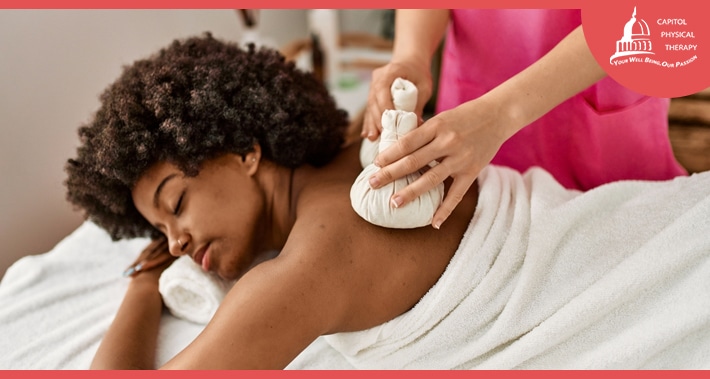
Have you or a loved one been recently diagnosed with degenerative disc disease?
If so, it can feel overwhelming.
But it’s important to remember that it doesn’t have to be a life sentence.
In fact, it’s a diagnosis that is starting to be phased out due to recent research.
And like many other orthopedic conditions, such as osteoarthritis or muscle strains, degenerative disc disease can be managed with the help of an experienced physical therapist for spinal issues.
Below, we explain more about degenerative disc disease and how our physical therapy can help those dealing with any of these spinal conditions find treatment solutions.
What Is Degenerative Disc Disease?
Most people will experience some form of lower back pain, upper back pain, or neck pain at some point in our lives.
Degenerative disc disease is one potential cause.
Degenerative disc disease occurs when the discs between your spine’s vertebrae begin to wear down due to injury or advanced age.
A normal spine has thirty three stacked bones, called vertebrae, which support it.
Between the discs are fluid filled cartilage sacs known as “intervertebral discs”.
When you’re young, these pieces of cartilage are primarily made of gelatin.
Over time, this gelatin decreases, and your intervertebral discs begin to flatten and lose their flexibility.
Ultimately, this results in less space between your discs, causing the bones to be closer together and sometimes causing the bones to press on the nerves.
Sometimes, bony build ups known as bone spurs form and stiffen your spine if contact between vertebrae is too common.
Usually, this process doesn’t cause any pain or discomfort, but can cause movement restrictions.
In some cases, though, having the vertebrae in closer contact with each other due to lost disc height can cause significant pain and inflammation.
You may feel this in just one area of your spine, or in several.
Degenerative Disc Disease Symptoms
As previously mentioned, degenerative disc disease doesn’t always present with symptoms.
In other cases, the pain associated with degenerative disc disease can become extreme.
The most common symptom of degenerative disc disease is mild to intense neck and back pain.
If your degenerative disc is in your neck, you might experience pain in your arms, shoulders, or neck.
If your degenerative disc is in your lower back, you might experience pain in your back, legs, and buttocks.
The pain is often made worse by sitting, bending, or reaching.
Additionally, the pain associated with degenerative disc disease is often the worst first thing in the morning or after periods of prolonged sitting.
In severe cases, degenerative disc disease causes nerve pressure that may lead to numbness, tingling, and weakness in your arms and legs.
How Does Pain From Degenerative Disc Disease Feel Like?
The pain caused by degenerative disc disease can vary.
For some, the condition causes little to no pain at all.
For others, the pain significantly affects their everyday lives.
Pain associated with degenerative disc disease includes pain that:
- Primarily affects the lower back
- Extends to legs and buttocks
- Extends from neck to arms
- Worsens after twisting or bending
- Worsens after sitting
- Comes and goes within the span of a few days to several months
How Does Someone Get Degenerative Disc Disease?
Degenerative disc disease is caused by the wear and tear of your intervertebral discs.
Often, this occurs as a natural part of aging.
Over time, your intervertebral discs naturally begin to dry out and lose support and function.
This process can begin in your early and 30s and 40s and progressively worsen.
In other cases, degenerative disc disease is caused by an injury or overuse of your spine.
Once damaged, your intervertebral discs can’t repair themselves, but in many cases your body will be able to adapt.
Risks factors for developing degenerative disc disease includes:
- Smoking
- Being overweight
- Continuous heavy physical work
- Lack of exercise
- Accidents, such as car accidents
RELATED: Healthy Seniors Physical Therapy
Is Degenerative Disc Disease The Same As Arthritis?
Degenerative disc disease and arthritis of the spine are not the same as they affect different tissues.
Left untreated, however, degenerative disc disease can cause osteoarthritis of the spine.

Why Is Degenerative Disc Disease Being Phased Out?
Modern research is beginning to suggest that a degenerative disc disease isn’t as useful as we once thought.
In a recent study, people with and without back pain were given MRIs and x-rays of their spines.
They found that most people, regardless of whether they were having pain or not, had what was interpreted as degenerative disc disease on imaging.
The authors argued that the position that people were in when the images were taken could have affected this.
But posture, movement patterns, form with exercise, ergonomics, and imbalances or asymmetries may play more of a role in chronic back pain.
Fortunately, all these causes can be treated with physical therapy.
How Can Physical Therapy For Degenerative Disc Disease Help?
Physical therapy is an excellent choice for symptom management of degenerative disc disease.
Your physical therapist is trained to help you manage symptoms in order to participate in everyday activities and responsibilities.
Your physical therapist might use a variety of techniques to help your symptoms, including:
1. Heat And Cold Therapy
Heat and cold therapy is a physical therapy technique that can help manage symptoms of degenerative disc disease.
Heat therapy, or thermotherapy, works by applying heat to affected areas in order to promote blood vessel dilation, blood flow, and help relax tight muscles.
In contrast, cold therapy, or cryotherapy, works by applying ice or cooling devices to affected areas in order to reduce blood flow and inflammation.
Both heat and cold therapy can help combat the pain associated with degenerative disc disease.
Speak to a physical therapist to find out which method might be best for you.
2. Exercises To Build And Maintain Flexibility
Your physical therapist can teach you specific exercises aimed to improve movement in your joints, as well as the muscles in your spine, arms, and legs.
Improving joint movement is a key component of chronic pain management physical therapy.
Therefore, exercises that help build and maintain flexibility are an important factor in symptom management.
3. Exercises To Build And Maintain Strength
Exercises that build and maintain strength are also important for symptom management of degenerative disc disease.
Strong trunk muscles are important for support of your spinal joints.
4. Dry Needling
Dry needling is a physical therapy technique that involves inserting fine needles into trigger points to relieve pain and inflammation.
Unlike intravenous or intramuscular injections, the needles don’t insert any substances into your body.
That’s why it’s called “dry” needling.
Dry needling can help alleviate muscle tightness which can help reduce compression at the spine and discs and help to restore better movement.
RELATED: Physical Therapy With Dry Needling
5. Posture Improvement
Finally, your physical therapist can help you improve your posture to help manage your pain.
Making small modifications in how you sit, stand, bend, lift, and even sleep is an excellent method of pain relief.
Your physical therapist will show you how you can improve your posture, so you can practice it on your own as well.
Book Your Appointment With Capitol Physical Therapy Today
If you’ve been recently diagnosed with degenerative disc disease, you might be feeling overwhelmed.
At Capitol Physical Therapy, we can help answer all your questions and create a treatment plan designed to your unique limitations and needs.
Don’t hesitate to consult with one of our experienced physical therapists to find out how we can help you.
Book your appointment with Capitol Physical Therapy to start managing your pain today.
1331 H St NW #200,
Washington, DC 20005
- https://g.page/capitolptdc
9560 Pennsylvania Ave. # 202,
Upper Marlboro, MD 20772
- https://goo.gl/maps/zjL4NnnuThRhrcS86
Capitol Physical Therapy offers orthopedic and other pain related solutions, with our versitile team of physical therapists in Washington, DC